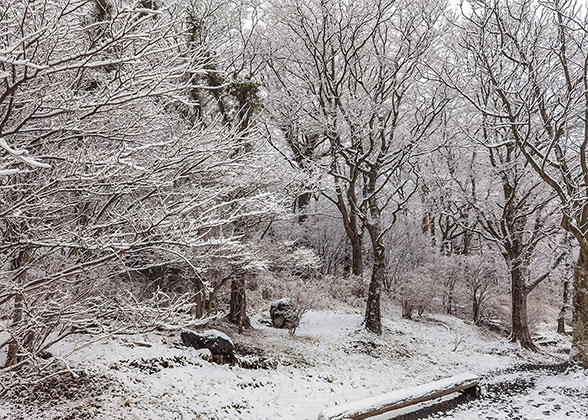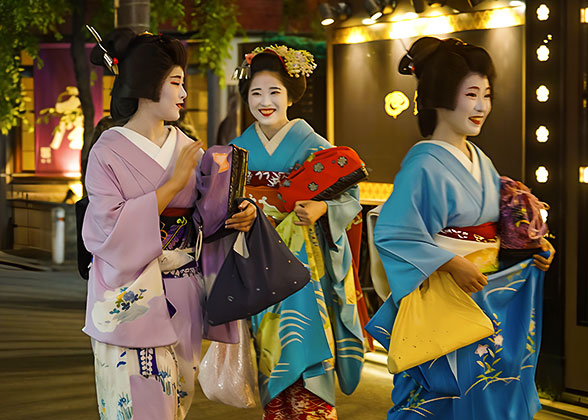Nagano Attractions
Located in the middle of Japan, Nagano can be the destination of your journey in Japan after visiting Tokyo and Yokohama in its east or Nagoya and Kyoto in its west. It is called “Japanese Switzerland” or “Roof of Japan” due to its unique geographic conditions of being surrounded by three mountains of the Japanese Alps: Hida Mountains, Kiso Mountains, and Akaishi Mountains. Numerous ski resorts scatter among them, such as Nozawa Onsen Ski Resort. They also boast scenic landscapes, including Kamikochi, Lake Suwa, and Jigokudani Yaen-Kone Wild Snow Monkey Park. Walking on the mountain trail surrounded by trees of hundreds of years of history, it is possible to see wild animals playing around and hunting. The scene of monkeys bathing in hot springs would amaze you greatly. Last but not least, for history lovers, Nagano would not disappoint them with its ancient buildings, shrines, and temples, as well as some modern buildings, like the arch church in Karuizawa.Tourist Attractions in Northern Nagano
1. Jigokudani Wild Snow Monkey Park

Jigokudani Yaen-Kone Wild Snow Monkey Park
|
Jigokudani Wild Snow Monkey Park is one of the famous shelters for Japanese macaques. This is a natural park without any fence or cage, so it is possible to observe these animals at a close distance. From December to March, monkeys would come and bathe in hot springs here. Most monkeys in the Park have been accustomed to the existence of visitors around, so they play with mates or enjoy bathing as usual. Remember not to bother them. Other than seeing monkeys, it is also recommended to take a walk on the forest trail that leads to the Park to enjoy the surrounding picturesque scenery.
2. Zenko-Ji Temple
The 1,300-year-old Zenkōji Temple is the most famous one among the numerous temples in Nagano. It has been designated as one National Temple by the Japanese Government. Legend has it that all human beings can be saved from the sea of misery after death in this Temple, rather than only Buddhists. Many buildings inside are important national properties of Japan, including Main Hall and the 20-meter-high (65 feet) Sanmon Gate. There is a mystery that the Temple collects Japan’s oldest Buddhist statue, which can only be seen in the special ritual held every 6 years. Apart from that, you can also see the bell which was used in the 1998 Winter Olympics. After visiting the Temple, you can relax by strolling along the commercial street nearby where local cuisines, fresh fruits, desserts, and crafts are offered.

Zenko-Ji Temple ( 29
|
3. Togakushi Shrine
Consisting of five main shrines, the 1,000-year-old Togakushi Shrine is surrounded by high cedar trees, many of which have been several hundred years old. Among them, one 900-year-old cedar tree has been designated as the national monument in Japan. The extremely tall forests make human beings so small that it is like a Lilliput where everyone’s body is very small but the buildings are huge.

Togakushi Shrine ( 12
|
4. Hakuba Valley
Hakuba is a good place to enjoy winter sports. As one of the venues for the 1998 Winter Olympics, Hakuba attracts visitors with its 11 resorts, more than 200 ski runs, and 146 cable cars. Some famous snow resorts include Tsugaike Kogen Ski Resort, Hakuba Goryu Snow Resort, and Hakuba Happo-One Snow Resort, which are respectively suitable for skiing beginners, intermediate-level skiers, and those with years of skiing experience. Apart from the regular skiing, Hakuba would also regularly hold exciting activities, such as race walking on snow, canoe competition, and wild skiing. In addition, luxury hotels, numerous bars, and restaurants would help you relax. On the top of the ski run, the Japanese Alps can also be seen on clear days.5. Karuizawa
Karuizawa is a comprehensive resort. Whether you want to see historical buildings or appreciate natural beauty, Karuizawa would satisfy your needs. Famous places include Kumoba Pond, Shiraito Waterfall, Stone Church, and Karuizawa St. Paul's Catholic Church. In addition, you can start an art journey in Karuizawa Picturebook Museum or Sezon Museum of Modern Art, or have a bathing in Tonbo-no-yu.6. Nozawa Onsen Ski Resort
Nozawa Onsen Ski Resort is one of Japan’s biggest sites for winter sports. The heavy snow in winter, which can reach 10 meters deep (33 feet), creates good conditions for skiing. Whether you are a skier with years of experience or a beginner, the Resort will satisfy your needs with its 44 ski runs, among which the longest is 10 kilometers (6.2 miles) and the shortest is 2 kilometers (1.2 miles). In addition, the Resort has 22 cable cars, on which you will see the Japanese Alps and the Sea of Japan in the distance. At night, don’t miss wonderful fireworks or go to drink sake to warm your body. If tired, the hot spring bath service will refresh your body.
Tourist Attractions in South and Central Nagano
1. Kamikochi

Kamikochi
|
2. Matsumoto Castle
With more than 500 years of history, Matsumoto Castle is the most ancient castle in Japan. The Castle’s main building inside – Tenshu (Main Keep) is one of the existing 12 Tenshus in Japan. Built by water and backed by the Japanese Alps, the Castel is very suitable to take photos on clear days. Whether on the day or at night, there would be various activities. For example, you can interact with staff dressed as samurais or take part in the festival celebrations held regularly around the Castle, and then you can taste delicious buckwheat noodles or see ice sculptures.

Matsumoto Castle ( 22
|
3. Lake Suwa
Lake Suwa is the largest lake in Nagano and it is famous for unique natural phenomenon. You can see the upward eruption of geyser from the bottom of the Lake, which can be 40 or 50 meters (130 or 165 feet) high. In winter after the lowest temperature stays below -10°C (14°F) for over 10 continuous days, the lake would freeze and due to the contraction and expansion of the ice, the lake surface would rise upwards more than one meter high (3 feet), which can be rarely seen in other places. Visitors who like cycling would like this place as there is a 16-kilometer-long (10 miles) path near the Lake and the bicycle-renting service is available nearby. In addition, the bathing pool which is the size of a swimming pool can’t be missed after cycling. From the middle July to September, you can appreciate fireworks shows nearly every night.

Lake Suwa on Clear Days
|
4. Tsumago-juku
As one of the most ancient villages in Japan, Tsumago-juku of Nakasendo Way has been designated as an important traditional building preservation area by the Japanese Government. Without the obstruction from electrical wires, you can observe the ancient buildings. At night, the lanterns hung in front of the houses make the village look peaceful. Near Tsumago-juku, there is a mountain trail. Lined with dense woods, it’s not hot walking on it even in summer, and you can see many farmhouses scattering around.
|
|
|
Itinerary Recommendation
Four days are enough to visit most tourist attractions in Nagano from the south to the north.Day 1: Lake Suwa → Matsumoto-jō Castle (42 mins’ car journey )→ Kamikochi (1 hour’s car journey)
Day 2: Kamikochi → Nozawa Onsen Ski Resort ( 2 hour’s car journey)
Day 3: Nozawa Onsen Ski Resort
Day 4: Jigokudani Yaen-Kone Wild Snow Monkey Park (1 hour’s car journey) → Zenkōji Temple ( 1 hour’s car journey) → Togakushi Shrine ( 30 mins’ car journey)→ head to your next destination
On the first day, you can first go to Lake Suwa to see the eruption of geyser or appreciate the scenery of the Lake and then leave for Matsumoto-jō Castle by car. It may be noon then. You can have your lunch first and spend your afternoon visiting the Castle. Later, arrive at Kamikochi to appreciate the scenery in the mountains.
On the second day, you can first go hiking in Kamikochi and then go to Nozawa Onsen Ski Resort to relax. Have a hot spring bath or enjoy your dinner to make preparations for the skiing on the third day.
On the third day, you can spend half day skiing in Nozawa Onsen Ski Resort and have a good rest in the afternoon.
On the fourth day, first, go to Jigokudani Yaen-Kone Wild Snow Monkey Park to take a walk on the mountain trail or see monkeys bathing in hot springs if you come here in winter. Then go to Zenkōji Temple to see various national treasures inside. Last, take Togakushi Shrine as the last destination of your journey in Nagano.
You May Like
-
 10 Days Private Tour of Tokyo - Mt. Fuji - Takayama - Shirakawa-go - Kanazawa - Kyoto - Nara - Hiroshima - Osaka from USD3809
10 Days Private Tour of Tokyo - Mt. Fuji - Takayama - Shirakawa-go - Kanazawa - Kyoto - Nara - Hiroshima - Osaka from USD3809 -
 7 Days Mini Group Tour with Japan Highlights: Tokyo - Mt. Fuji - Kyoto - Nara - Osaka from USD2155
7 Days Mini Group Tour with Japan Highlights: Tokyo - Mt. Fuji - Kyoto - Nara - Osaka from USD2155 -
 8 Days Mini Group Tour: Tokyo - Hakone & Mt. Fuji - Kyoto - Nara - Osaka - Hiroshima - Osaka from USD2771
8 Days Mini Group Tour: Tokyo - Hakone & Mt. Fuji - Kyoto - Nara - Osaka - Hiroshima - Osaka from USD2771

